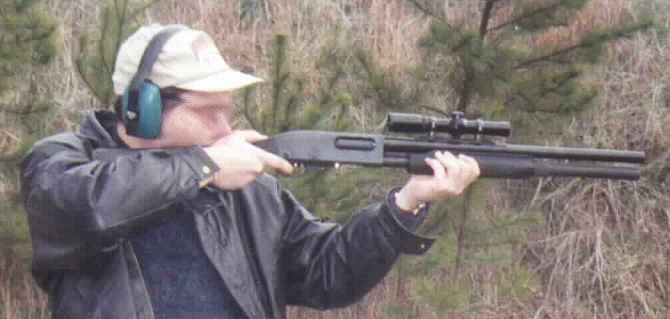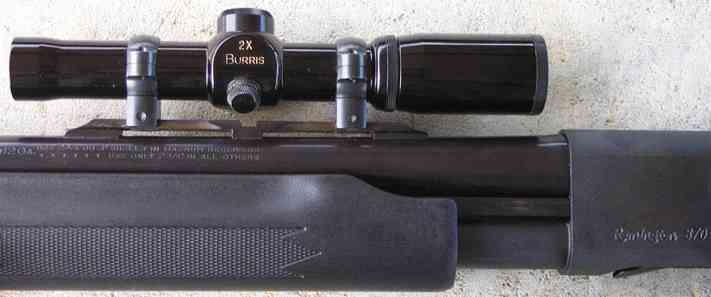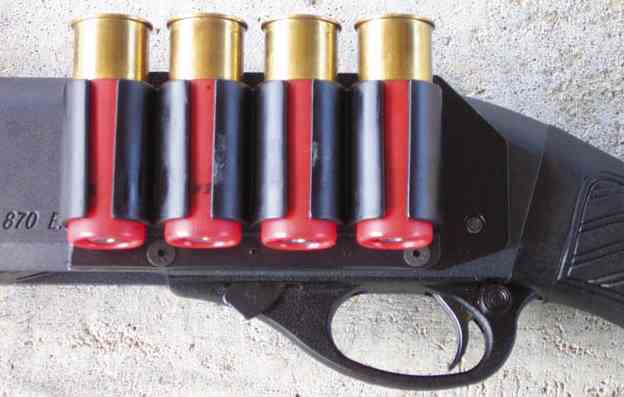

As y'all know, I'm a big fan of the Beretta 1201FP combat shotgun. But guess what? The factory just hosed it up. I was ready to shell out about four hundred and sixty simoleons for a post-Ban five-round model at the last pre-NICS gun show last month when I decided to give the thing a really thorough going-over before handing in that yellow sheet and a stack of bills.
Actually, it was pissing me off that Beretta changed the gun to only hold five rounds although there are no laws which required them to (apparently they wanted to suck up to the law enforcement market, and the easiest way to do that is to offer Officer Donut something that mere civilians can't buy) so I was actively looking for an excuse to blow the purchase off, and hoo-daddy, did I find it.
Get this, not only did they crimp the front end of the magazine (which is typical for this sort of operation), but they also PERMANENTLY ATTACHED THE ENDCAP ASSEMBLY! I depressed the detent and managed to burr the heck out of the threaded and slotted cap with my multi-tool, but could not get it to budge at all in either direction.
If you are not up to speed on repeating scatterguns, what that means is that if your magazine spring kinks up so that one coil slips through another -- which is the most common non-operator malfunction to plague tube-fed shotguns -- you'd have to ship the bastard in to the factory to have it fixed. That's completely unacceptable, especially in a supposedly serious firearm.
So I handed the FFL guy the box back, and bought a Remington 870 Express Magnum instead. The "Express" series consists of Remington's low-rent models, which can be found at any local WalMart or K-Mart. Mine went for just under $250 out the door. I could have gotten one for even less, but I insisted on a synthetic buttstock and forearm, and a barrel that accepted interchangeable chokes.
Oof! I forgot what a difference steel makes. My Beretta has an aluminum receiver and weighs-in at about 6.3 pounds, which to me feels about perfect. The steel receiver on the 870 makes it tip the scales at over seven pounds.
(Greater weight would usually be considered to be better kick-wise, but here is a strange thing about recoil: Big beefy guys can be punished more by it than smaller gents like myself -- although I weigh-in at about 175 pounds of mostly booze flab -- because they generally lack a shoulder "pocket" into which the butt can comfortably be placed. I finally figured that out during Louis Awerbuck's shotgun class. The only students who did not get bruised-up over three days of shooting hundreds of rounds of buckshot, slugs, and birdshot were myself, a slim teenager, and this tall stringy dude.)
The 870's metal had a Parkerized-looking "crackly" finish, which is fairly aesthetically appealing, although I suspect that the reason that Remington chose it was because it better concealed the fact that they changed the triggerguard over to some sort of miracle plastic. Unfortunately, it is NOT Parkerizing, so don't expect it to provide anywhere near that level of corrosion protection.
I enjoyed shooting the thumper, but a big bonus check convinced me to start noodling with the gun.
Another inspiration was Wiley Clapp's recent article "'Tactical' Buckshot & Chokes" in the June '98 edition of American Rifleman. Wiley and pals ran nine different loads of 00- and 000-buck through six different chokes, ranging from cylinder bore (a straight-open barrel) to Full (relatively tightly-constricted at the muzzle-end) to the semi-exotic Vang-Comp special barrel (don't ask), and then listed the number/percentage of the pellets that hit a 12" circle at 25 yards.
What caught my eye about Clapp's article was first that they found a load/choke combo that would put ALL the pellets from four consecutive rounds into the 12" target. Now I recently did a bit on buckshot using an unchoked gun, and the best load I found would put all the pellets from a single cartridge into patterns ranging from 9.25" to 12.5" at only 15 yards. The overall pattern from a total of five rounds was much larger.
Secondly, Clapp claimed that he witnessed a combination (the Vang-Comp with Fed Tactical 000-Buck) that could place all of its pellets onto a man-sized silhouette target at 65 yards!
Now, is THAT something?
I say "Yes" for at least one big reason: Switching over from shot cartridges to a solid slug to do the job at longer ranges is a snorting pain in the ass when you are under pressure.
On the semi-auto 1201FP, where a round is not advanced from the magazine unless the trigger is pulled, the "proper" sequence for sticking in a slug is:
Unfortunately, on most pumps the process is more complicated because working the action will alway advance another round, so the "proper" drill with a gun fully-loaded with shot shells is to:
Obviously neither system makes the slug option very attractive. The ideal -- sought after for so long by the manufacturers of steel-dart flechette cartridges -- is to find a single load that can serve both close-up and at a distance.
I set down my beer and decided upon a goal. I wanted to see how far away a shotgun could consistently place three 000-buck pellets into the scoring zone of a B-27 target.
. . .
Last month's Gun List had an ad from Cape Outfitters which mentioned Remington 20-inch #6231 cantilever replacement barrels for the 870. This arrangement consists of a steel mount which projects over the receiver, onto which a rifle scope can be attached.
Just got it in today. Once I got the preservative stuff off the thing looked real nice with the exceptions of the rather purplish magazine support and the finish damage where the mount was brazed (or however) on. The barrel was blued and thus did not match the rest of the firearm, but that was not much of a problem as problems go.
Luckily the actual cantilever component is not required, which is a good thing as it is as stupid-looking a contraption as you can imagine. There is already a solid-humping base on the barrel itself, and the extension doohickey attaches to it via four screws and a sloppy indexing flange. The questionable nature of this tack-on rig is exemplified by the fact that there is a rubber button on the underside to prevent the overhang from contacting the top of the receiver. No thank you.
Just looking at the design makes it obvious that Remington's engineers planned on a true forward-mount from the beginning, but their marketing boys probably convinced them that America's geezers would balk at buying something as new-fangled as a PISTOL optic.
The preferred setup is to mount a long eye-relief handgun scope directly on the Weaver-type base on the barrel via the supplied rings, which of course fit it perfectly.

(PLEASE NOTE: Remington has changed the design of this barrel type! The new ones look a lot sturdier because they are attaching a solid one-piece cantilever directly, but this eliminates the pistol-scope option. In addition, a "Monte Carlo"-type stock -- which serves to raise the shooter's eyeline an inch or so -- is now standard on the factory complete guns because this method requires the scope to be placed higher than what is comfortable to use with a traditional buttstock. So if you want to follow my lead, be sure to insist on a #6231 while they are still around!)
. . .
I loved the package. It came with an Improved Cylinder choke tube, rifled choke tube, nice rings, choke wrench, etc., all for $125 delivered. Unfortunately, the rings are much thinner clamp-wise than true Weavers and thus are not interchangeable, but since they were "free" and are made of steel, I can't kick too much.
The rifled choke obviously did not interest me much for this project, and the IC was not going to give me much improvement over a standard riot gun's cylinder bore. My 870 came with a Modified choke tube, so I called a distributor and ordered a Full and Extra- Full, which are popular with turkey hunters, for thirteen bucks each so that I could do some mixing and matching. They were out of the Extra-Fulls, which turned out to be a good thing.
The next toy in the shopping cart was a Burris 2x pistol scope with Posi-Lock. (I actually wanted to try out one of their zero-magnification 1x XER scopes, but could not find anyone that sells them.) I saved about $25 by ordering a "Factory Blemish" sample from Natchez Shooter's Supply. The optics were nice and clear, and the only flaw I noticed on the unit was that the threads on one of the covers were very slightly chewed-up.
Apparently the spring-loaded Posi-Lock screw works as advertised because the scope has been holding true since I tightened down the components the first weekend after it arrived.
I also ordered a TacStar sidesaddle shell holder at the same time. When it showed up I followed the instructions to the letter, but surprise, surprise, the pump would not fully retract because it was being blocked. Then I caught the caveat TacStar snuck in:
Put plainly, I was being instructed to take a saw to a $250 gun in order to mount a $15 accessory. Bullshit. 1-3/4" is more than a "minor" mod -- I consider that a major bit of slice and dice. Another thing that I consider much more pertinent is that when it's cold and wet and you're stoked on adrenalin, you CAN'T have enough forend to hang on to.
So I decided to sacrifice the TacStar's front two loops instead. I whanged off the recommended 1.75" with my hacksaw, and then gave the new sharp edges a few licks with a rough file. I cut off the remaining half-loop with my pocketknife, then drilled and tapped two 6-32 holes near the front end to keep the leading edge of the plastic part from flapping around. I did not use the factory flush-fitting screws because that would've required radiusing the thin plastic around the screw holes. Rather, I cut down two standard Philips screws. They were far enough forward that their exposed heads did not interfere with extracting the muzzle-end shell.

It just so happened that I'd been sitting on an 870 extended magazine tube for four or five years, which came into my possession in exchange for about fifteen bucks worth of ammo. It cranked on tight and holds securely after hard use, thanks perhaps in part to the spring-loaded detent ball positioned on the cantilever's forward attachment point, an amenity Remington no longer bothers to provide on their cheaper barrels these days. Also, they cutely try to discourage the use of high-capacity devices by placing two crimps at the end of the factory tube. It took all of two minutes to drill them out with my Black & Decker cordless. (For more information on what the BATF boys insist that you legally can and cannot do with a shotgun, check out the handy Rec.Guns overview at http://www.recguns.com/IIM.html.)
When I was installing the mag extension I noticed the flimsiness of the thin plastic shell follower, and ordered a Choate non-bind replacement ($5). It's a solid chunk with a "tail" which is supposed to help prevent the spring from kinking-up. It's also bright orange, so you can tell at a glance whether there are rounds in the magazine . . . although that's a questionable safety practice, especially after the advent of all-plastic shotshells years ago.
Next up was a jumbo-head safety ($7). The factory unit was small enough to require a deliberate effort to locate and disengage it. The replacement sticks WAY out, and readily pops off when I crook my finger around the trigger, which is exactly right. I used to be a big fan of tang-mounted safeties on shotguns (ala the Browning BPS and the various Mossbergs), but this system is superior in that it demands even less thought.
Two other quick modifications were required to attach a sling. First, I drilled the back of the buttstock (well ahead of the lower buttplate screw's path) so that it would accept an Uncle Mike's 3/4" wood QD stud. There's a strengthening rib along the bottom edge of the stock, so there's no worry of it pulling free. Next I stuck an extra Beretta 1201FP forward sling swivel around the mag extension. After puzzling over how to keep it in place, I dug a small hose clamp out of the tool kit and used that to hold the swivel up against the knurled cap at the mag extension's rear.
. . .
Since I have a wealth of crap to play with and an insatiable lust for recoil, I played around with mixing and matching the various pieces parts.
Here's a tip that I picked up off the neat Firearms Tactical site (http://www.firearmstactical.com/tactical.htm):
It just so happened that I had a box of Winchester 2-3/4" #1 Buck sitting in my closet, so I gave it the same treatment outlined above with the modified choke in place:
Obviously, the key to the FT quote is your definition of "typical shotgun engagement distances". Most folks use them for home defense, where 25 feet would be a long shot, and up-close patterns would obviously be much tighter. So for indoors, the #1 buck makes perfect sense for the reasons given.
At greater distances, #1 has problems. The larger groups I experienced increase the chances of missing a target with one or more pellets, which will be much more likely to endanger bystanders than a hit which overpenetrates. Second, each pellet of #1 only weighs 40 grains (the same as a .22 Long Rifle roundnose bullet), whereas a piece of 00 buck is just shy of 54 grains, and 000 weighs 68 grains. The greater heft of the larger sizes means more effective penetrating power at longer ranges.
I snagged four boxes of sabot slugs earlier this year when a local WalMart clearanced out a big chunk of its ammo supply after hunting season ended. With the Remington rifled tube in place, I fired five three-shot groups at fifty yards. The largest was 1.875", and the smallest ran 1.1". That's pretty impressive.
Just for yucks, I put four rounds of the Federal reduced recoil buck through the tube at to see what effect the twist would have on the shot at 25 yards:
That is not very impressive. As the second set of numbers hint, the group was rather doughnut shaped, with a big ol' patch of nothing in the middle. It's even worse performance than most unchoked guns could deliver.
Finally, rifled tubes are meant to work with sabots. Foster-type slugs won't gain anything from the experience.
I was actually glad that the modified tube proved better for buckshot than the full, because I'd be kind of uncomfortable shooting slugs through the tighter choke.
I practiced loading slugs from the TacStar while in the prone position (which is a mite clumsy), and shot four 4-shot groups with 1-oz. Winchester standard 2-3/4" at fifty yards. The smallest went just under 2", and the largest was 3.6". The scope helped make the results a lot more consistent than what I typically get from rifle-sighted shotguns as there were no fliers, but I did not fully appreciate that fact until moving to a bench.
Using my pistol case as a rest, I fired four 4-round groups at 100 yards. The results ranged in size from 3.1" to 4.7", with all the rounds falling comfortably inside the 6" black scoring area of an NRA SR-21 bullseye. That's the type of performance I'd expect from an old military rifle with iron sights firing surplus ammo -- which may not sound like high praise, but keep in mind that:
All things considered, that kind of accuracy is pert' near astonishing.
. . .
On to fifty yards!
(More MAY be on the way . . .)